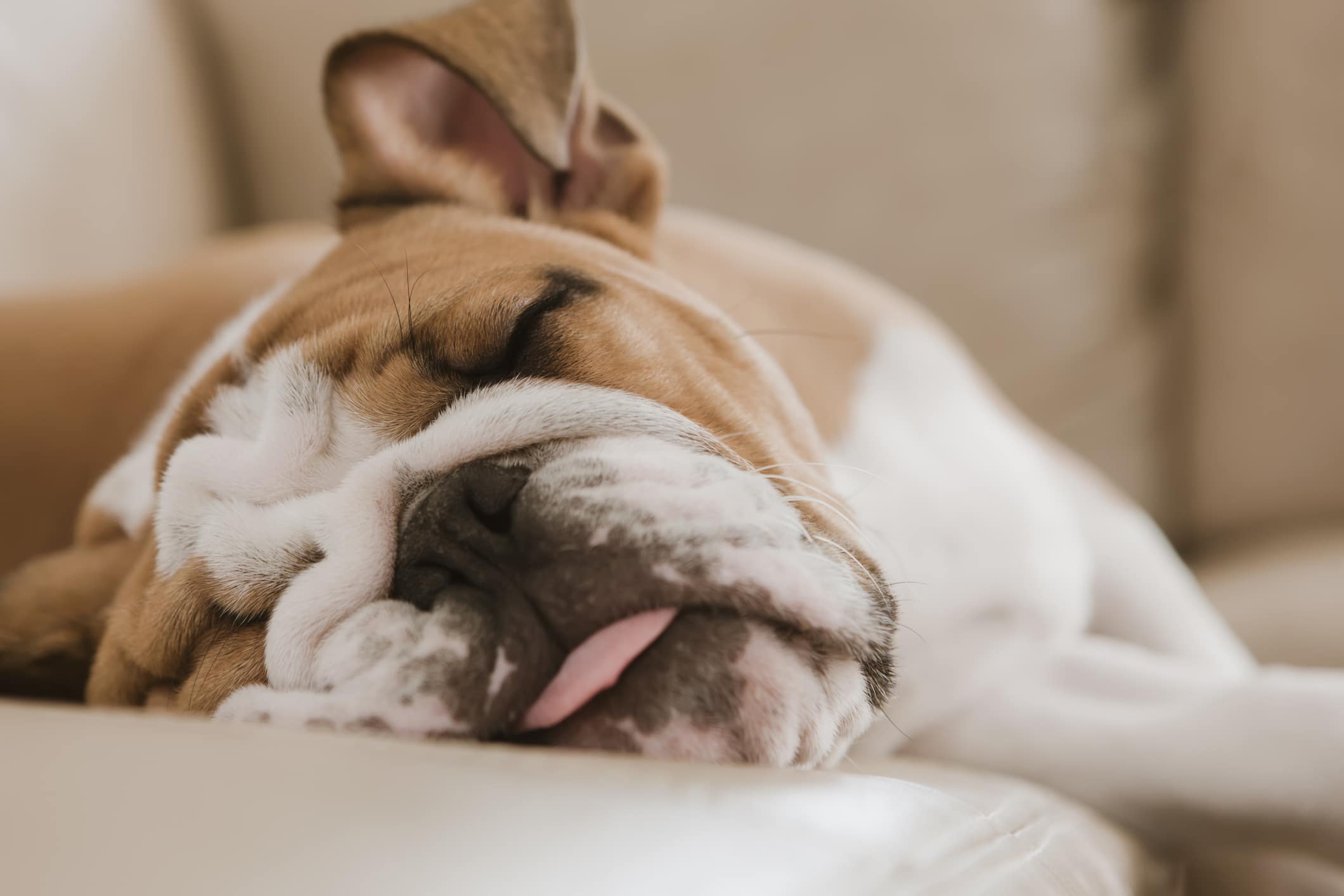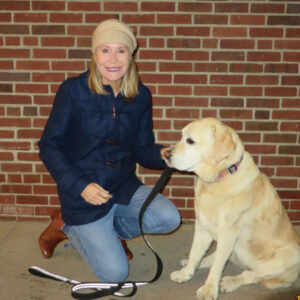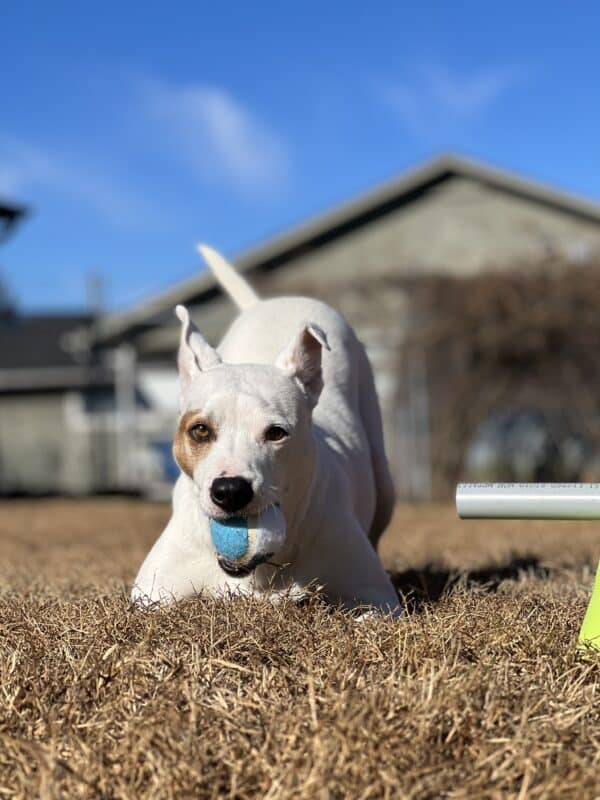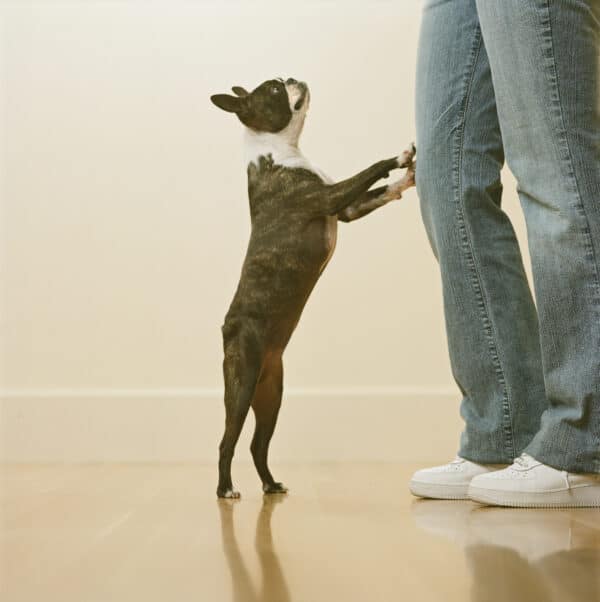Sure, you’ve seen your dog twitch her paws, move her legs and even let out a little cry while she sleeps. Perhaps you’ve even witnessed your pooch exhibit more dramatic movements or sounds when she sleeps and wonder, do dogs dream?

Do Dogs Dream?
Dr. Stanley Coren, Professor Emeritus in the Department of Psychology at the University of British Columbia, literally wrote the book on it: “Do Dogs Dream? Nearly Everything Your Dog Wants You to Know.”
Dr. Coren’s answer to the question in his book title is: Yes. “All the evidence seems to indicate that dogs dream,” he says. “It’s probably the case that all mammals dream.”
In humans, most dreams occur during the rapid eye movement (REM) phase of sleep, while increased electrical activity exists in our brains. And scientists discovered that many mammals, from rats to dogs, also have periods of REM sleep with elevated brain electrical activity.
Dr. Chad West, the head of neurology and neurosurgery at the Schwarzman Animal Medical Center in New York City, has seen this on snoozing dogs monitored by electroencephalography or EEG machines.
“The wave patterns that show brain activity of sleep that are exactly the same in people occur in dogs,” Dr. West says.
This evidence has led many researchers to conclude that dogs likely dream.
What do dogs dream about?
If dogs dream, what do they dream about?
“That’s the million-dollar question,” says veterinarian Zarah Hedge, Chief Medical Officer at the San Diego Humane Society. “We don’t know what exactly they’re dreaming about. It’s so much easier with humans because we can just tell you, ‘Here’s what my dream was.'”
Research shows that mammals likely dream about experiences they had during the day. Scientists at the Massachusetts Institute of Technology (MIT) monitored rats’ brain waves as they ran a maze and then when they slept. They found many rats had the same brain patterns during each activity — so the rats thought about the maze while asleep.
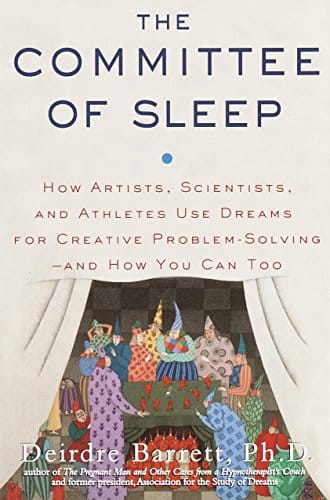
Dr. Deirdre Barrett, a psychologist and teacher at Harvard Medical School, who wrote “The Committee of Sleep,” says humans often report their dreams correlate with what they’ve focused on during the day. So, if you apply the findings of all this research to your dog, you might get the answer you’ve been dreaming about: They think of you!
“It leads me to think that most dogs would be likely to dream about their owners frequently,” Dr. Barrett says. “Food, toys and their favorite walks would be other likely candidates for most dogs.”
How can you tell if your dog is dreaming?
Dogs usually enter the REM stage 20 to 40 minutes after falling asleep and remain in that phase for approximately two and a half minutes. Your dog’s breathing becomes irregular and her eyes will move.
“You’ll start to see the dog’s eyes flipping around,” Dr. Coren says.
You may see legs quiver, paws flutter, tails wag or hear a whimper or whine. That is all normal.
But what if a dog’s dream seems over the top? Or loud? My partner and I were jarred awake recently one night. Intense howling followed by menacing growling echoed through our home.
Blurry-eyed, our feet hit the floor. We stumbled around in the dark. What was going on? Was there a werewolf? A full moon? Did someone leave on the TV?
We found the culprit, our Labrador, Jackson. Though asleep on his bed, he had transformed into a horror movie sound machine. Was this a nightmare?
Is my dog having a nightmare?
If you think your dog is in the midst of a bad dream or a nightmare, experts say stay calm.
“Don’t freak out if your dog seems to be having a noisy dream. It’s going to pass in a couple of minutes,” Dr. Coren says.
If your dog is especially vocal or animated in his dreams, it doesn’t necessarily mean there’s a problem. “If they’re growling or barking, that’s stuff they would normally do during the day, and it doesn’t necessarily mean they’re upset,” Dr. Hedge says.
Learning this made me feel better about Jackson’s Oscar-winning sleep performance. We thought he had PTSD and was reliving the days he was a stray — likely fending off coyotes and predators chasing him in the dark — and needed therapy.
But Dr. West doesn’t think so. After telling him about Jackson’s behavior and Labrador-like prey drive, Dr. West wonders if Jackson was dreaming about not catching a squirrel he stalked during the day.
Mammals’ brainstems are supposed to prevent humans and animals from acting out their dreams, but occasionally some activity, like Jackson’s, slips through.
“What he is wanting to do is making it through,” Dr. West says. “His brain seems to be wired with this immense prey drive. If you have a very, very strong, robust stimulus, your brainstem just isn’t potent enough to stop all of it.”
Dog sleep disorders
Some dogs surpass Jackson’s sleep theatrics and need medical intervention because they have a REM-associated behavior disorder.
These dogs may get up while asleep and move around. Or even propel or flip themselves off the couch or bed, yet not wake up. It’s similar to a sleepwalking person.
“That is because they don’t have the normal inhibitory functions to prevent that,” Dr. West says. “It’s very concerning in some pets because you worry that they’re going to injure themselves in their sleep.”
Dr. West doesn’t think Jackson has a REM-associated behavior disorder, but if your dog has very physical dreams, contact your veterinarian. There are medications that may help.
Should I wake my dreaming dog?
Since no one knows precisely what your dog dreams about, be cautious not to startle them while they are asleep and risk being bitten.
“If they’re feeling threatened in their dream, and you suddenly awaken them, there is a moment when the line between dreaming and consciousness is blurred. The dog might react negatively to you. They might snap at you,” Dr. Coren says.
Experts say just let dogs dream, but if you must wake them, don’t touch them or put your face near their body.
“You can try calling their name or gently shake their beds to get their attention,” Dr. West says.
Why REM sleep is important for dogs
Another reason not to wake sleeping dogs is because REM sleep is when mammals’ brains review what happened during the day and consolidate it into their memories.
“It’s like looking in your computer to see which files you could discard because you don’t need them anymore,” Dr. Coren says. “So, you peek into each file, and if you’re not going to use it again, you delete the file.”
If dogs don’t have a chance to snooze and dream, researchers believe it’s harder for them to create long-term memories.
“It’s important for dogs to have a good night’s sleep, especially if you’re trying to teach them things that you want them to retain,” Dr. Coren says. “If you wake them up, they’re not going to be as rested, and their brain will not be as restored.”
Can you give your dog sweet dreams?
While no one knows how to ensure dogs have sweet dreams, Dr. Coren has a suggestion. “Since dreams tend to be replays of what’s going on during an average day — if you give your dog lots of good, positive, average days, then he’ll have lots of good, positive dreams,” he says.
And though Jackson can’t tell me what he’s thinking or dreaming about, I have a feeling he supports Dr. Coren’s theory, especially if treats are involved.

